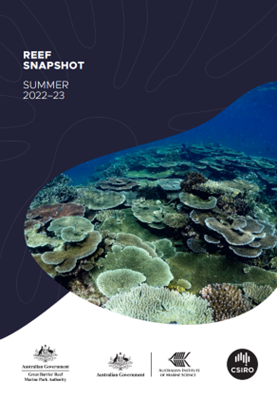A relatively mild summer is expected to have provided further relief for the Great Barrier Reef, according to the Reef snapshot: summer 2022/23 (link), released today.
The annual Reef snapshot, is a concise, easy-to-understand summary of what the Reef experienced over the summer. It is a joint initiative by the Great Barrier Reef Marine Park Authority (the Reef Authority), Australian Institute of Marine Science (AIMS) and the CSIRO.
"Summer is a critical time for the health of the Great Barrier Reef," said AIMS CEO Dr Paul Hardisty.
"Queensland's tropical wet summer brings warmer sea temperatures, cyclones and runoff from increased rainfall - and corals are susceptible to all three. These events, as well as ongoing crown-of-thorns starfish outbreaks, can quickly reduce live coral cover or reduce coral health, degrading the habitat for other life on the Reef.
"The Reef snapshot brings important information together so people can understand how the Reef fared during the season," he said.
Data from all three agencies, as well as the Bureau of Meteorology are used to inform the Reef snapshot. The Reef snapshot: summer 2022/23 reports:
- While sea temperatures in spring were the hottest on record, summer sea temperatures were at or slightly above average. Minor bleaching was seen in all three regions (northern, central and southern), however there was no mass coral bleaching.
- Monsoonal conditions caused some rivers to reach major flood levels, with flood plumes reaching offshore reefs in the northern region and the Whitsunday Islands in the central region.
- No cyclones entered the Marine Park. Large swells from TC Gabrielle which tracked outside the Reef in February may have caused some damage to some reefs on the outer edge.
- Crown-of-thorns starfish outbreaks continue on reefs in the southern region, particularly in the Swains reefs.

The Crown-of-thorns Starfish Control Program continues to work in all three regions to cull starfish down to non-outbreak levels. The Great Barrier Reef Marine Monitoring Program water quality team collected samples from areas affected by flooding to better understand the impact of the events.
Dr Hardisty said the relatively mild conditions were a welcome relief for the Reef.
"Results from the AIMS Long-Term Monitoring Program in 2022 showed coral cover in the northern and central regions had reached its highest recorded levels.
"But we are not complacent. Ongoing crown-of-thorns starfish outbreaks continue to reduce coral cover in the southern region. Last year, the Reef experienced a mass bleaching event - the fourth since 2016 and the first during a cooler La Niña year. Luckily it was less severe than the 2016 and 2017 mass bleaching events. The long-term effects of the event are currently being assessed and will be included in the AIMS' Long-Term Monitoring Annual Summary Report later in the year.
"Climate change means each summer brings increased risk of intense marine heatwaves and more severe cyclones and flooding. We know gains in coral cover can be lost quickly, and the impacts of climate change make it harder for the Reef to recover," he said.
Dr Hardisty said the three Australian Government agencies and their collaborators work closely together to understand coral health.
"The Reef is incredibly large, complex and its number one threat is climate change. The combined effort of our three agencies and our partners ensures the best available science is used to inform management decisions to protect it for future generations," he said.
The Reef snapshot: summer 22/23 is available from the Reef Authority website.
Featured image credit: The Reef Authority.






